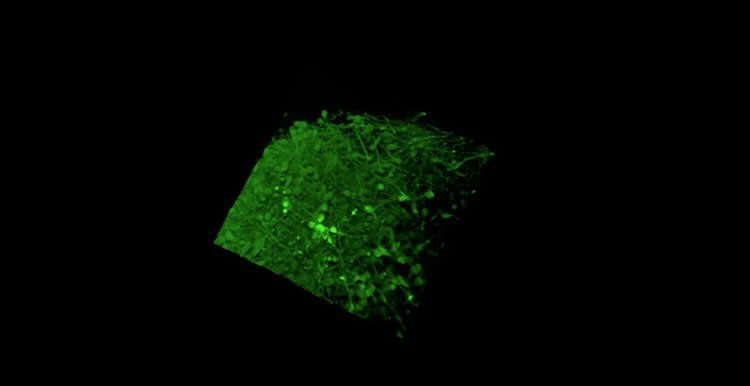Summary: Researchers used hPSCs to grow an organoid that produces inhibitory neurons and plays a critical role in the early development of the cortex.
Source: Yale University.
Scientists can now explore in a laboratory dish how the human brain develops by creating organoids — distinct, three-dimensional regions of the brain. In research published in Cell Stem Cell, Yale scientists coaxed early stage stem cells to create and fuse two types of organoids from different brain regions to show how the developing brain maintains proper balance of excitatory and inhibitory neurons.
A failure to maintain this balance has been implicated in a host of neurodevelopmental disorders such as autism and schizophrenia.
“The inhibitory neurons migrate from specific areas of the embryonic brain to the region where excitatory neurons are being produced,” said senior author In-Hyun Park, associate professor of genetics and associate professor in the Child Study Center. “What we did is to fuse these two areas and watched the process unfold.”
The Yale team used human pluripotent stem cells to grow an organoid called the human medial ganglionic eminence, which produces inhibitory neurons and plays a crucial but brief role in early development of the cortex. By merging this structure with another that produces excitatory neurons they could track migration of the inhibitory cells, which provide a crucial check on excitatory neurons.

Understanding the process will not only help researchers understand how the human brain evolved, but shed light on how imbalances contribute to many neurodevelopmental disorders.
For instance, excess activity by excitatory neurons has been implicated in schizophrenia while too much inhibitory neuronal activity may contribute to depression, Park said. The imbalance has also been linked to development of autism spectrum disorders he said.
Funding: Yale’s Yangfei Xiang and Yoshiaki Tanaka contributed as first authors of the paper, which was funded primarily by Connecticut Stem Cell Research Grants.
Source: Bill Hathaway – Yale University
Image Source: NeuroscienceNews.com image is credited to Yale University.
Original Research: Abstract for “Fusion of Regionally Specified hPSC-Derived Organoids Models Human Brain Development and Interneuron Migration” by Yangfei Xiang8 Yoshiaki Tanak, Benjamin Patterson, Young-Jin Kang, Gubbi Govindaiah, Naomi Roselaar, Bilal Cakir, Kun-Yong Kim, Adam P. Lombroso, Sung-Min Hwang, Mei Zhong, Edouard G. Stanley, Andrew G. Elefanty, Janice R. Naegele, Sang-Hun Lee, Sherman M. Weissman, and In-Hyun Park in Cell Stem Cell. Published online June 27 2017 doi:10.1016/j.stem.2017.07.007
[cbtabs][cbtab title=”MLA”]Yale University “Lab-Created Mini-Brains Reveal How Growing Organ Maintains Neuronal Balance.” NeuroscienceNews. NeuroscienceNews, 27 July 2017.
<https://neurosciencenews.com/neural-balance-mini-brain-7191/>.[/cbtab][cbtab title=”APA”]Yale University (2017, July 27). Lab-Created Mini-Brains Reveal How Growing Organ Maintains Neuronal Balance. NeuroscienceNew. Retrieved July 27, 2017 from https://neurosciencenews.com/neural-balance-mini-brain-7191/[/cbtab][cbtab title=”Chicago”]Yale University “Lab-Created Mini-Brains Reveal How Growing Organ Maintains Neuronal Balance.” https://neurosciencenews.com/neural-balance-mini-brain-7191/ (accessed July 27, 2017).[/cbtab][/cbtabs]
Abstract
Fusion of Regionally Specified hPSC-Derived Organoids Models Human Brain Development and Interneuron Migration
Highlights
•hMGEOs and hCOs recapitulate human brain organization and fetal brain transcriptomes
•Transcriptome and chromatin accessibility distinguish hMGEOs and hCOs
•hMGEOs and hCOs display activity-dependent and synchronized calcium oscillations
•Interneurons migrate from hMGEOs and functionally integrate in hCOs
Summary
Organoid techniques provide unique platforms to model brain development and neurological disorders. Whereas several methods for recapitulating corticogenesis have been described, a system modeling human medial ganglionic eminence (MGE) development, a critical ventral brain domain producing cortical interneurons and related lineages, has been lacking until recently. Here, we describe the generation of MGE and cortex-specific organoids from human pluripotent stem cells that recapitulate the development of MGE and cortex domains, respectively. Population and single-cell RNA sequencing (RNA-seq) profiling combined with bulk assay for transposase-accessible chromatin with high-throughput sequencing (ATAC-seq) analyses revealed transcriptional and chromatin accessibility dynamics and lineage relationships during MGE and cortical organoid development. Furthermore, MGE and cortical organoids generated physiologically functional neurons and neuronal networks. Finally, fusing region-specific organoids followed by live imaging enabled analysis of human interneuron migration and integration. Together, our study provides a platform for generating domain-specific brain organoids and modeling human interneuron migration and offers deeper insight into molecular dynamics during human brain development.
“Fusion of Regionally Specified hPSC-Derived Organoids Models Human Brain Development and Interneuron Migration” by Yangfei Xiang8 Yoshiaki Tanak, Benjamin Patterson, Young-Jin Kang, Gubbi Govindaiah, Naomi Roselaar, Bilal Cakir, Kun-Yong Kim, Adam P. Lombroso, Sung-Min Hwang, Mei Zhong, Edouard G. Stanley, Andrew G. Elefanty, Janice R. Naegele, Sang-Hun Lee, Sherman M. Weissman, and In-Hyun Park in Cell Stem Cell. Published online June 27 2017 doi:10.1016/j.stem.2017.07.007






